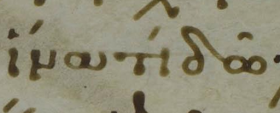Nowadays students are routinely informed that there’s only one accent which matters in Greek: τίς, τί and related forms mean ‘who’ and ‘what’, while τις, τι etc. mean ‘a certain’.
That’s probably true as far as the texts which modern students read, but it’s wrong from a manuscript perspective, wrong historically, and wrong if you care about how the NT was pronounced.
Two passages to illustrate:
Matthew 11:27 where modern editions tend to print οὐδὲ τὸν πατέρα τις ἐπιγινώσκει ‘nor does anyone know the father’
However, this is not what the manuscripts contain and we can see how the accent has dropped out during the history of printed editions:
John 13:29 where modern editions tend to print ἵνα τι δῷ ‘that he [Judas] might give something’
Grave accents marking indefinites are also found in manuscripts, but they are much rarer than acute ones. The strong distinction between accented forms for a question and unaccented for an indefinite is artificial. It all depends how much emphasis there is on the indefinite. Manuscripts do not always agree on this, but on many occasions they present wide agreement against modern editions in seeing an indefinite form as marked. I say, let’s bring back the accent.
[Copious thanks should be given to the CSNTM for providing images used here and to Peter Montoro for his work in reviewing enclitic vs non-enclitic accents for the Greek New Testament in preparation at Tyndale House, Cambridge, under the editorship of Dirk Jongkind.]
That’s probably true as far as the texts which modern students read, but it’s wrong from a manuscript perspective, wrong historically, and wrong if you care about how the NT was pronounced.
Two passages to illustrate:
Matthew 11:27 where modern editions tend to print οὐδὲ τὸν πατέρα τις ἐπιγινώσκει ‘nor does anyone know the father’
However, this is not what the manuscripts contain and we can see how the accent has dropped out during the history of printed editions:
GA 03
GA 560
GA 757
GA 788
GA 1424
Erasmus 1516
Stephanus 1550
Mill 1707
John 13:29 where modern editions tend to print ἵνα τι δῷ ‘that he [Judas] might give something’
GA 560
GA 771
GA 788
GA 1424
GA 2907
Erasmus 1516
Stephanus 1550
Mill 1707
Grave accents marking indefinites are also found in manuscripts, but they are much rarer than acute ones. The strong distinction between accented forms for a question and unaccented for an indefinite is artificial. It all depends how much emphasis there is on the indefinite. Manuscripts do not always agree on this, but on many occasions they present wide agreement against modern editions in seeing an indefinite form as marked. I say, let’s bring back the accent.
[Copious thanks should be given to the CSNTM for providing images used here and to Peter Montoro for his work in reviewing enclitic vs non-enclitic accents for the Greek New Testament in preparation at Tyndale House, Cambridge, under the editorship of Dirk Jongkind.]


























